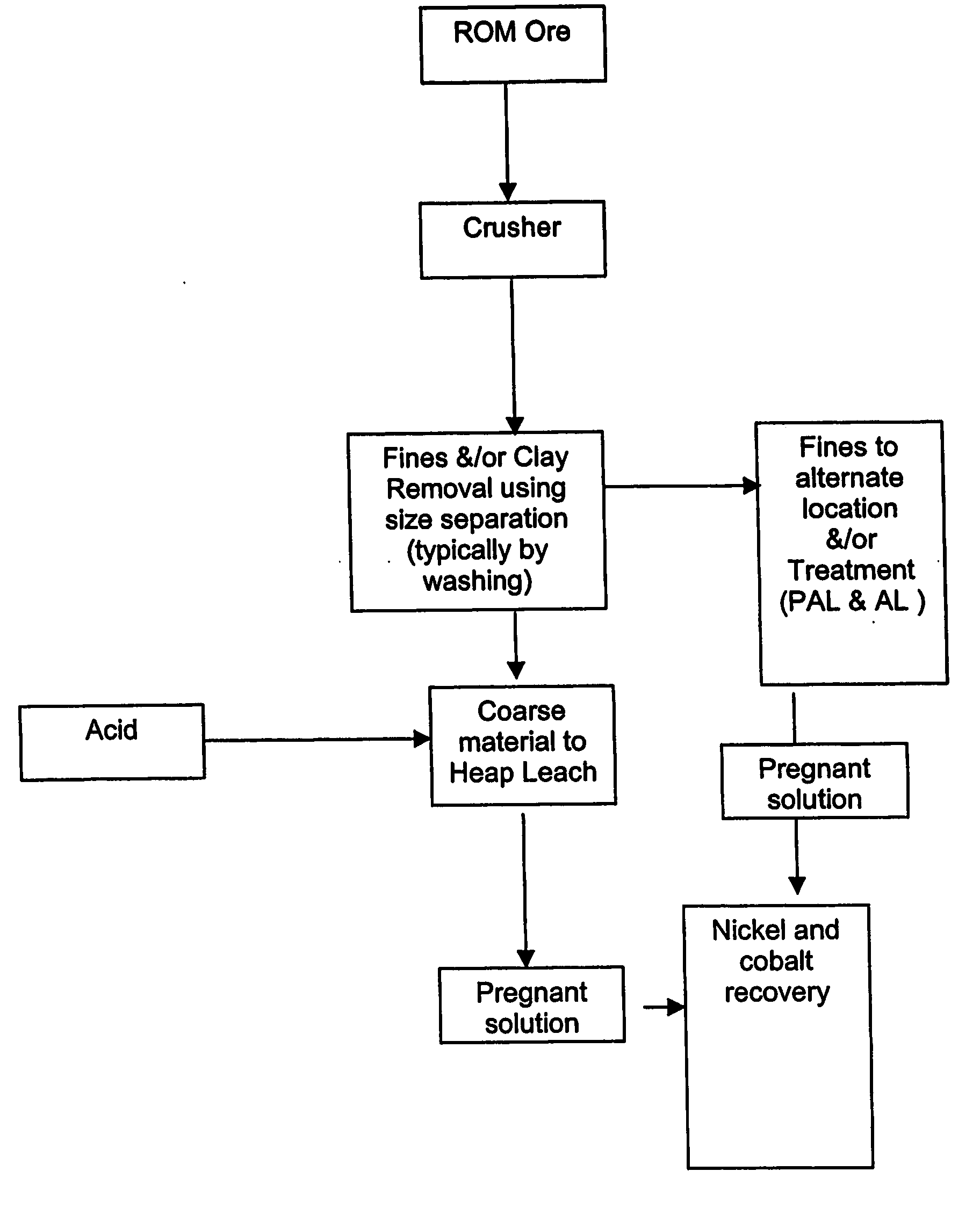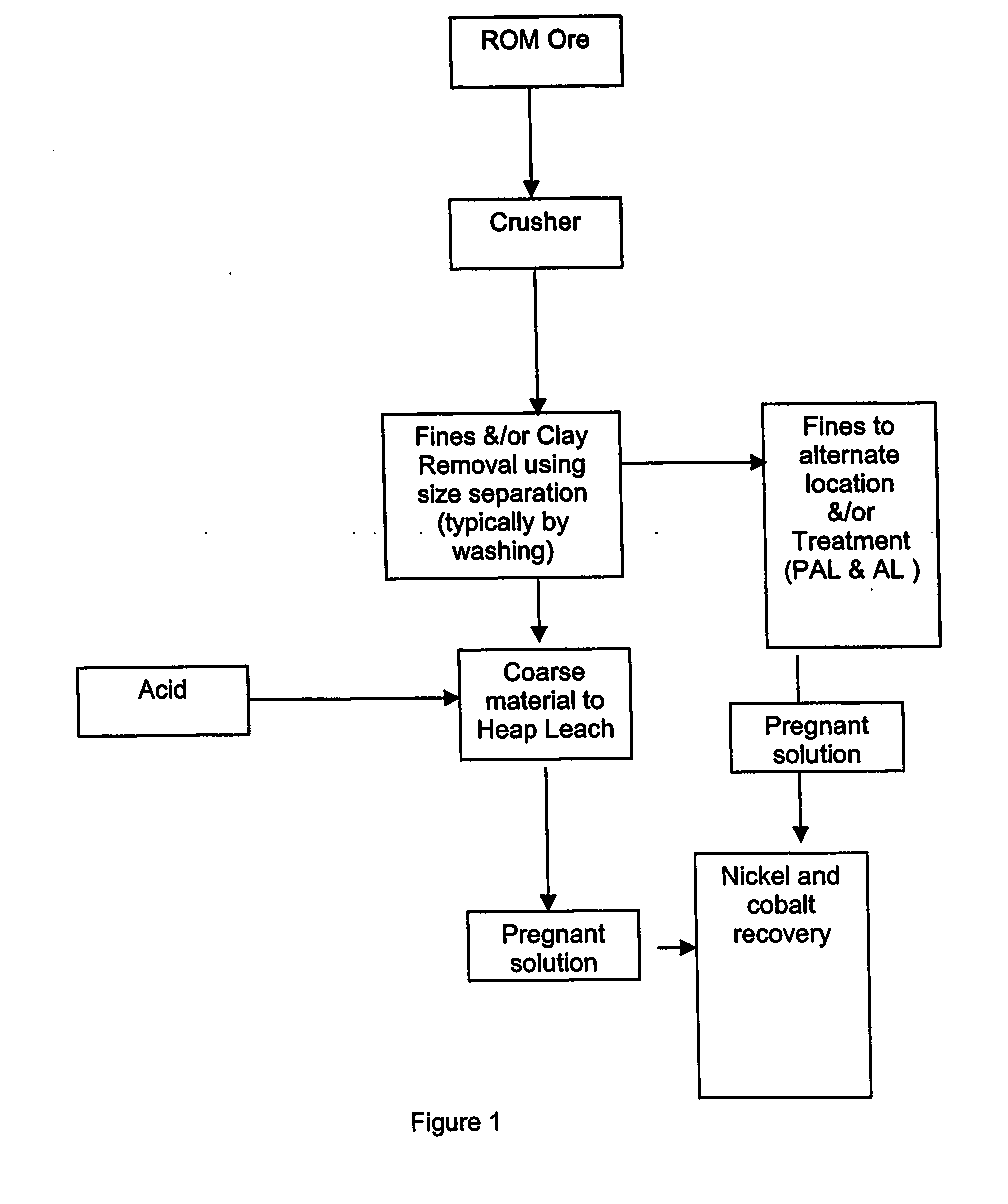Process for recovery of nickel and cobalt by heap leaching of low grade nickel or cobalt containing material
a technology of nickel ore and cobalt, which is applied in the direction of nickel compounds, solvent extraction, separation processes, etc., can solve the problems of low grade ore being rejected as waste, total treated ore quality, and high processing cost, and achieve the effect of enhancing the leaching of nickel and cobal
- Summary
- Abstract
- Description
- Claims
- Application Information
AI Technical Summary
Benefits of technology
Problems solved by technology
Method used
Image
Examples
example 1
[0040] Tests were carried out on a dry laterite ore, characterised by containing a large amount of barren quartz and the relative absence of clays. Nickel in the laterite is associated predominantly with the intrinsically fine goethite, which is easily separated from the harder, coarser quartz material. The goethite / limonite zone and saprolite zones are characterised by the occurrence of abundant siliceous net-veins and box-works, which impart properties conducive to beneficiation.
[0041] The beneficiation process involves the physical separation (scrubbing, screening and classification) of the high-grade fine fraction of the ore (product) from the coarse low-grade fraction (reject). Nickel is predominantly associated with very fine-grained iron hydroxide minerals in the limonite zone and very fine-grained weathered nickel-magnesium silicates as well as the very fine-grained iron hydroxide minerals in the saprolite zone. These nickel-bearing minerals are softer than and encapsulated...
example 2
[0052] The size fractions of the laterite ore beneficiation low grade rejects samples used in Example 1 were recombined in their respective proportions in the original ore for the following testwork to produce a test sample for both the limonite and the saprolite low grade rejects. The analysis of the composite samples is shown in table 3.
TABLE 3The Composition of the Ore Charged into ColumnColumnWet Wt.H2OAlCaCoFeMgMnNiSiCO3I.D.Kg%%%%%%%%%%Saprolite31.119.20.171.260.124.1011.160.070.5025.6710.80Limonite31.518.20.370.400.0310.304.180.160.6832.153.60
[0053] Samples of each reject limonite and saprolite ore were loaded to a height of 4 m in 75 mm diameter clear Perspex columns, and treated with sulphuric acid solution to replicate heap leaching. The feed solution for the columns was 50 g / L sulphuric acid in brine containing 56 g / L total dissolved salt (27 g / L sea salt and 29 g / L added salt).
[0054] Acid addition flux rates were progressively increased to a maximum target level of 120...
example 3
[0060] In order to demonstrate the potential for the use of a low grade saprolite heap leach to be used to treat the leachate from a low grade limonite heap leach to remove some of the dissolved iron and neutralise excess acid values, a synthetic product leach solution was prepared to replicate that produced from the column leaching of the low grade limonite test in Example 2. The solution analysis is indicated in table 7. This solution was used to treat low grade saprolite ore rejects in a column leach test as described in Example 2. The results of the leach after 168 days are indicated in tables 8 and 9 below.
TABLE 7Composition of Synthetic Limonite Leach product solutionTotalH2SO4AlCoFeMgMnNiSea saltsaltDissolvedg / Lg / Lg / Lg / Lg / Lg / Lg / Lg / Lg / LSalt g / L203.300.2237200.252.2272956
[0061]
TABLE 8Comparison of Feed and Leach Product Solution fromthe Saprolite Neutralisation Column after 168 daysH2SO4AlCoFeMgMnNig / Lg / Lg / Lg / Lg / Lg / Lg / LSynthetic203.300.2237200.252.2Limonite Columnleach soluti...
PUM
| Property | Measurement | Unit |
|---|---|---|
| size distribution | aaaaa | aaaaa |
| size distribution | aaaaa | aaaaa |
| concentrations | aaaaa | aaaaa |
Abstract
Description
Claims
Application Information
 Login to View More
Login to View More - R&D
- Intellectual Property
- Life Sciences
- Materials
- Tech Scout
- Unparalleled Data Quality
- Higher Quality Content
- 60% Fewer Hallucinations
Browse by: Latest US Patents, China's latest patents, Technical Efficacy Thesaurus, Application Domain, Technology Topic, Popular Technical Reports.
© 2025 PatSnap. All rights reserved.Legal|Privacy policy|Modern Slavery Act Transparency Statement|Sitemap|About US| Contact US: help@patsnap.com



